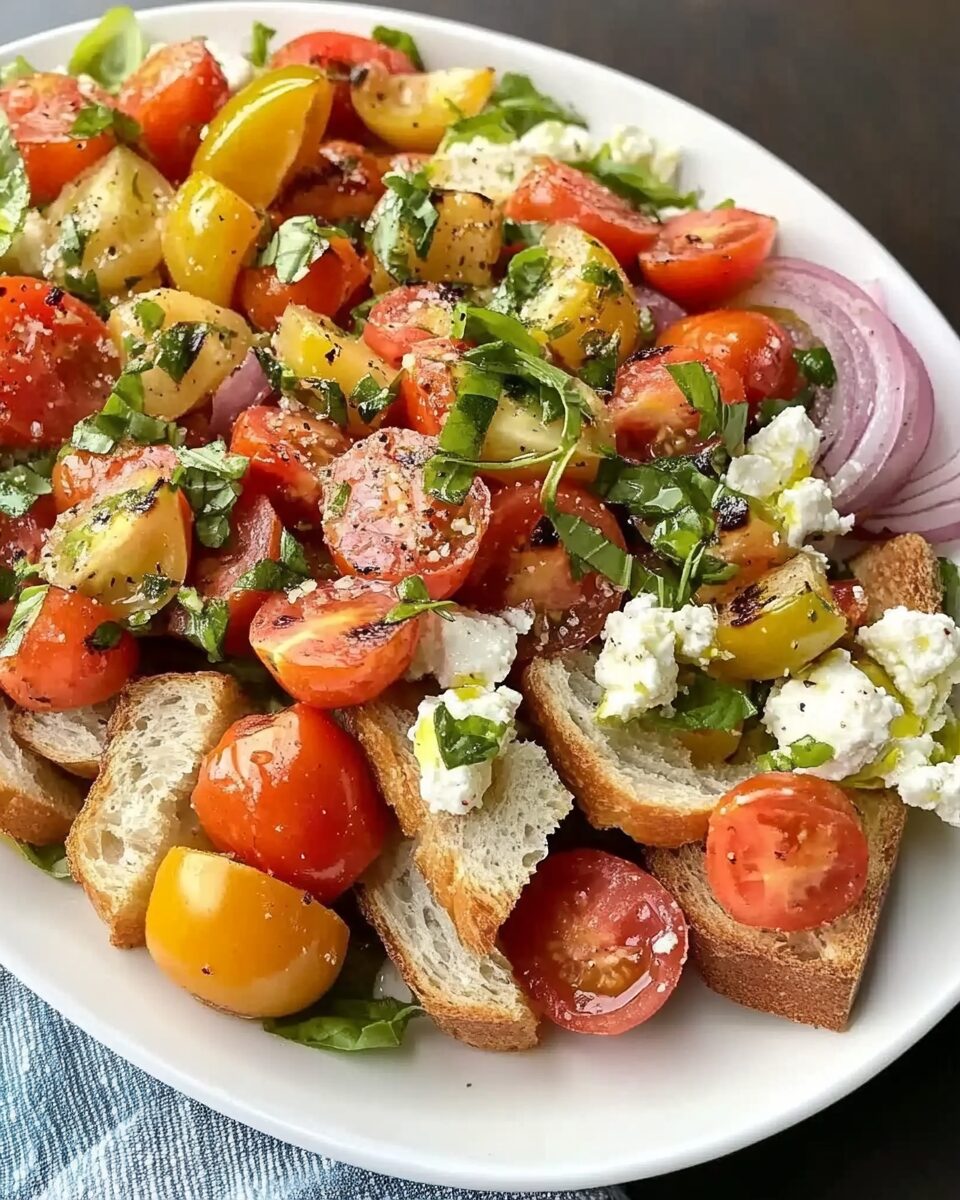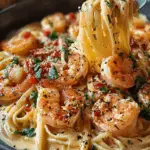A Brief History of Panzanella
Originating in central Italy, particularly Tuscany, Panzanella was initially a way for farmers and home cooks to avoid wasting stale bread. In its earliest forms, the salad included bread soaked in water and vinegar, along with onions and other vegetables from the garden. Tomatoes weren’t introduced into the mix until the 20th century, but now they are considered essential to the dish’s identity.
Panzanella has evolved over time, influenced by regional variations and modern culinary trends. While purists may prefer a no-frills version with just tomatoes, onions, and basil, contemporary takes often include cheese, cucumbers, olives, and even grilled vegetables. The version in this recipe emphasizes smoky, grilled bread and heirloom tomatoes, offering a fresh spin on a timeless favorite.
The Role of Grilled Bread
One of the hallmarks of this upgraded Panzanella Salad is the use of grilled crostini instead of stale bread. By toasting baguette slices on a hot grill pan, you introduce a beautiful char and a satisfying crunch that balances the softness of the tomatoes. The result is bread that holds up better when tossed with juicy produce, maintaining a chewy interior with crisp, smoky edges.
Rubbing the warm bread with garlic is a simple yet transformative step. It infuses the crostini with a subtle aromatic bite that deepens the overall flavor of the salad. When the grilled bread pieces are tossed with olive oil, salt, and tomato juices, they soak up just enough liquid to become tender while still retaining some bite—creating the perfect texture contrast in every mouthful.
Tomatoes: The Star of the Show
No ingredient in Panzanella is more important than the tomatoes. Heirloom tomatoes are preferred for their varied colors, textures, and complex flavors, but any ripe, in-season tomato will do. The key is juiciness—because much of the salad’s dressing comes from the natural juices released by the tomatoes when they’re salted and gently tossed with olive oil.
The tomatoes bring brightness, acidity, and natural sweetness to the salad, balancing the richness of the olive oil and the saltiness of the grilled bread. Their juices act as the binding element of the salad, helping all the components meld together into one cohesive and flavorful dish.
Fragrant Additions: Basil and Red Onion
Fresh basil is another essential element of a good Panzanella, lending herbal, slightly peppery notes that amplify the freshness of the tomatoes. Chopped roughly and added at the end, basil not only enhances the flavor but also adds vibrant color.
Red onion, thinly sliced, adds a bit of sharpness and crunch. When tossed with the tomatoes and allowed to marinate briefly, the onion’s intensity mellows, blending more harmoniously with the rest of the salad. If you’re particularly sensitive to raw onion flavor, you can soak the slices in cold water for 10 minutes before adding them, which reduces their pungency while preserving their texture.
Cheese as a Creamy Upgrade
While cheese is not traditional in Tuscan Panzanella, the addition of feta or burrata introduces a luxurious, creamy element that complements the rustic texture of the salad. Feta contributes a tangy, salty punch that contrasts beautifully with the sweet tomatoes and basil. Burrata, on the other hand, offers a milky richness that oozes over the salad, creating a luscious mouthfeel with every bite.
Either option elevates the dish into something more substantial, making it suitable as a stand-alone meal for lunch or a light dinner. If you want to keep it vegan, the salad is just as satisfying without the cheese—thanks to the savory grilled bread and bold tomato flavor.
Perfect for Summer and Entertaining
Panzanella Salad shines brightest during summer, when tomatoes and basil are at their peak and outdoor grilling is in full swing. It’s a fantastic addition to cookouts, picnics, and garden parties because it can be served at room temperature and holds up well over time. In fact, some might argue that it tastes even better after sitting for 10–15 minutes, allowing the flavors to mingle and the bread to soak up the juices.
It’s also a highly adaptable dish that welcomes experimentation. You can add cucumbers for extra crunch, grilled corn for sweetness, or kalamata olives for briny depth. Swap the bread with sourdough or focaccia, or try using flavored olive oils or a splash of balsamic vinegar to build additional layers of taste.
Health Benefits of This Salad
Not only is Panzanella Salad delicious and satisfying, but it also offers a wide range of nutritional benefits. Tomatoes are packed with antioxidants, including lycopene, which supports heart health and reduces inflammation. Olive oil, especially extra virgin, is a staple of the Mediterranean diet and is known for its heart-healthy monounsaturated fats and anti-inflammatory properties.
Whole grain or artisan-style breads provide fiber and complex carbohydrates, while fresh herbs like basil add vitamins and essential oils. If you opt for cheese, you’ll also get a good dose of calcium and protein—turning this simple salad into a well-rounded meal. Even without cheese, it’s a plant-forward dish rich in vitamins, minerals, and healthy fats.
Make-Ahead and Storage Tips
While best enjoyed fresh, Panzanella Salad can be partially prepared ahead of time. You can grill the bread, slice the onions, and chop the tomatoes a few hours before serving. Keep the components separate and toss them together shortly before mealtime to preserve the texture.
Leftovers can be stored in the refrigerator for up to a day, although the bread will continue to soften over time. Some people enjoy this ultra-soggy texture, while others may prefer to re-toast a few bread pieces and toss them in for added crunch before serving the next day.
Conclusion
Panzanella Salad with Grilled Crostini is a vibrant, flavorful tribute to the Mediterranean tradition of cooking with intention and simplicity. It turns humble ingredients into a rustic masterpiece that’s as satisfying as it is beautiful. With juicy heirloom tomatoes, fragrant basil, smoky grilled bread, and creamy optional toppings, this salad is a celebration of summer’s bounty and a reminder that good food often comes from the simplest ideas.
Whether you’re using up a loaf of bread from earlier in the week, harvesting tomatoes from the garden, or just seeking a dish that feels fresh, light, and soul-satisfying, this Panzanella delivers. Make it once, and you’ll find yourself returning to it again and again—each time customizing it to fit the moment, the season, or the guests around your table.






